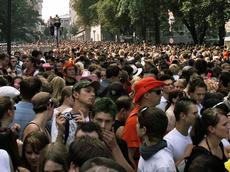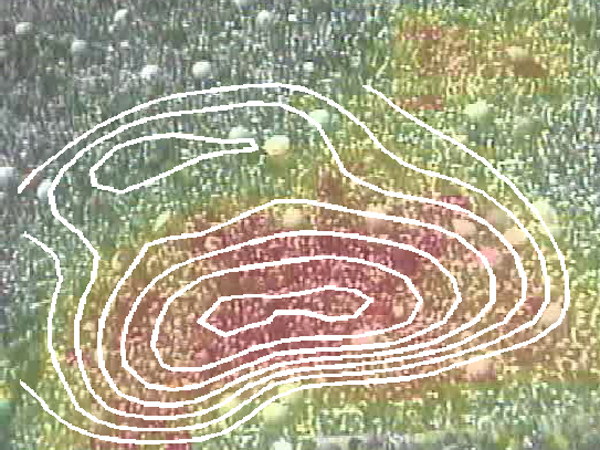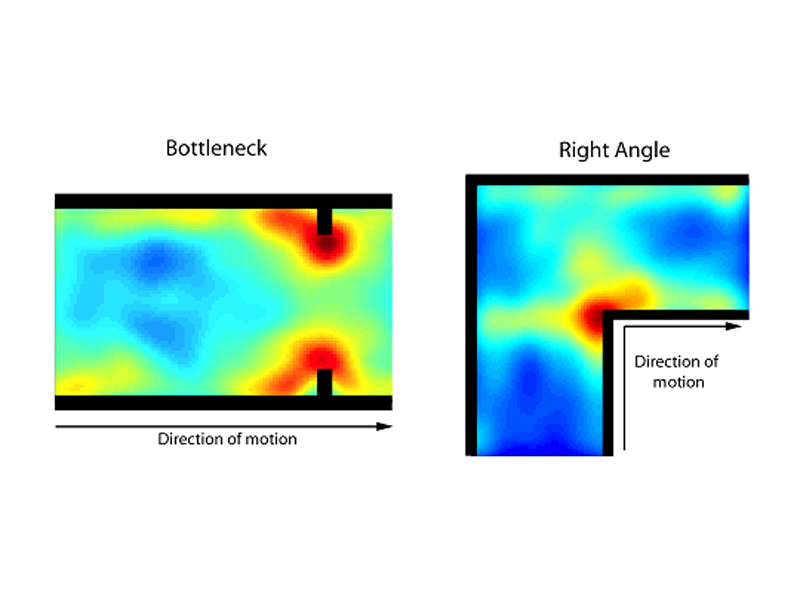Hunting for gaps
Researchers have developed a new model for the behavior of pedestrians and crowds. It can help to understand and prevent tragic crowd disasters, to develop better architectural designs and new navigation approaches in robotics.

During rush hours, every train station is flooded with people on the way to or from work. The crowds stream from the tracks to the exits, the escalators, the bus stops. Despite this, collisions are rare. Sometimes one person makes way, sometimes another, but everyone gets to the destination amazingly quickly. Mehdi Moussaid and Guy Theraulaz from the CNRS in Toulouse and Dirk Helbing from ETH Zurich have now developed a simple cognitive model that explains how pedestrians move and how the surprising self-organization of human flows comes about.
Computer simulation models of
pedestrian and crowd behavior are not new per se. However,
today's simulation softwares are often based on physics-inspired assumptions,
such as repulsive forces between pedestrians. The new, psychologically based
model, in contrast, assumes that pedestrians try to minimize the coverage of
their vision field, while adjusting the walking speed to keep a safety distance
from other people. It is based on two heuristic rules – decisions that people make without much
thinking about their behavior. If you combine
these rules with the contact forces that occur in extremely high pedestrian
densities, the model can also realistically depict crowd disasters.
Hunting for gaps
Previously it was assumed that each obstacle has a repulsive
effect on pedestrians. The new approach instead assumes that pedestrians are
seeking gaps, and that groups are perceived as a whole. In contrast to previous
models, which decompose a pedestrian’s
environment into separate effects, the new approach describes the scene in a
holistic, integrated manner. In response to a complex environment, a person may
re-align, slow down his or her steps or deviate from a certain direction to
avoid collisions. Nevertheless, nobody realistically calculates thousands of variations to select the optimum
route. That is done, for example, by some approaches in robotics, where people
are sometimes seen as a homo economicus,
i.e. strict optimizers. However, it is sufficient to apply simple rules to find
the almost perfect path of minimum effort through the crowd, says Helbing.
Approach simpler than expected
The
researchers verified their model with different data sets, from the single
individual up to flows of pedestrians at bottlenecks and in evacuation
situations. Never
before were so many different tests conducted to support a model, says Helbing,
but this was necessary since the new model represents a paradigm shift. It is a scientific breakthrough, because experts
believed that a cognitive approach would be much more complicated than a
physical one. "Now we experience a big surprise: The cognitive model is
substantially simpler!"
With
the new model, researchers can simulate the behavior of individuals as well as
the movements of crowds. The simulations demonstrate that pedestrian flows
self-organize. When pedestrians walk in opposite directions, such as in a
heavily frequented railway underpass, separate lanes of uniform walking
direction form - both in the model and in reality. This minimizes mutual
obstructions, and makes the flow of pedestrians more efficient. It may be seen
as a result of collective intelligence.
If a crowd quake strikes
The
model also shows what can happen if the pedestrian density exceeds a critical
value. If people have to go shoulder to shoulder, stop-and-go waves may arise.
If the density increases even further, the
coordinated pattern breaks down completely, giving rise to a turbulent motion
which can eventually lead to fatal crowd disasters, in which people are
trampled to death.
Helbing has observed that, before such a disaster, the crowd
undulates, and people trapped in the crowd are pushed back and forth and, in
fact, into all possible directions. The forces are transmitted from one person
to another and add up, sometimes over distances of more than 10 meters, and
potentially with fatal consequences.
“Force chains are forming, which can push people suddenly into unpredictable
directions, almost like in an earthquake. "
In such a "crowd quake", one can easily fall to the ground, and the
disaster takes its course.
Real-time video analysis could help prevent disasters
… as it happened in Duisburg , Germany, recently. At the Love
Parade in the summer of 2010, 21 people died in a crowd disaster, and over 500
were injured. The new model can help to elucidate
the cause of the accident and plan prevention measures for future mass events.
At first, it was assumed that the disaster had happened because people fell
from a narrow staircase onto the crowd. A closer analysis, however, reveals
that the crowd began to undulate before the panic broke out. "A crowd
quake was the cause of the disaster." Crowd management at major events
needs special tools to assess such situations. For example, a real-time
analysis of surveillance videos can help to save lives, as it facilitates to
recognize earlier where problems are building up.
Crisis management by the FuturICT Flagship Project
The
project illustrates what is planned on a much larger scale by the “FuturICT” EU
flagship project, led by Helbing. Pedestrian crowds are a perfect example of a
social system, in which social interactions can lead to unintended
consequences. Even though normal pedestrians try to avoid harming others, crowd
disasters have occurred again and again. How they happen has long been a
mystery, but thanks to a better understanding of social interactions, the
underlying mechanisms have been identified, and early warning signs as well.
Moreover, one can take counter measures and prevent crises, as has been
successfully shown by the re-organization of the Hajj, the annual Muslim
pilgrimage to Mecca.
"From this perspective, the pedestrian crowd project fits the framework of FuturICT perfectly, which aims to develop new risk management tools. “Indeed, one of the goals of the project is to prevent disasters through the use of new computer technologies and by learning to better understand the complexity of social systems," says Helbing.
Reference
Moussaid M, Helbing D, Théraulaz G. How simple rules determine pedestrian behavior and crowd disasters. PNAS. DOI: 10.1073/pnas.1016507108
International workshop on crises
An international workshop on Coping with Crises in Complex Socio-Economic Systems will be held in Zurich, June 20-25 2011. Social systems typically feature crises, i.e. unstable and dangerous situations that are characterized by abrupt and large-scale changes. Such disruptions are very hard to predict with any precision and even harder to control. Indeed, crises often convey an impression that key decision makers have lost control and that events unfold in an unstoppable and even catastrophic way. Examples include environmental crises, the collapse of transportation systems, as well as financial and social crises such as poverty, social conflicts or wars. These and other issues will be addressed during the meeting.









READER COMMENTS